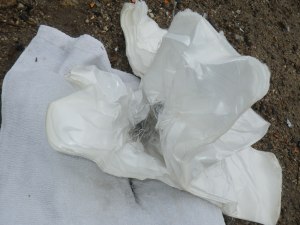Because bullets and fragments are not the only threats out there, current technology has developed ways of dealing with some of the oldest weapons known: sharpy pointy things.
Ballistic armor is designed to stop high velocity projectiles, while cut/stab armor is designed to stop very slow (relatively!), sharp and pointed objects from cutting/piercing the wearer’s skin.
This type of armor is a continuation of the most ancient forms of personal armor, which has seen the use of bone, fabric, leather, and finally metal. It is interesting that the current state of technology has returned to the use of fabric as the primary defense against thrusting and cutting implements.
As it has been for millenia, there are always trade-offs in terms of protection vs. weight/concealability. The most protective suits, while they can be made with extremely good ergonomics, will tend tno be hotter, heavier, and far from low-profile. Semi-rigid and rigid armors, which include forms of metal mesh (traditional “maille”), interlocking articulated plates (metal or metal/composite), lamellar, or solid plates are very efficient at stopping cuts and thrusts. Their weight and heat burden tend to be fairly high. Materials range from stainless steel, titanium, to rigid para-aramid (Kevlar/Twaron).
Fabric materials are currently used in the majority of concealable stab/cut vests. These include the familiar materials Kevlar, Twaron, and Spectra. As before, UHMWPE laminates should be eschewed, even though they may provide better numbers in terms of weight. The known weaknesses of this material outweigh any benefits. Generally, the Para-Aramids are woven, similar to their ballistic counterparts, but are much tighter weave. This is to prevent spikes from pushing the fibers aside. The number of layers is directly proportional to the protection levels, which are rated in a similar way to ballistic standards. They are:
KR1/SP1 (Knife Resistant Level I/Spike Protection Level I) – Lowest level, resists knife thrusts and spike stabs at 24J up to 36J
KR2/SP2 (Knife Resistant Level II/Spike Protection Level II) Medium level, resists knife thrusts and spike stabs at 33J up to 50J
KR3/SP3 (Knife Resistant Level III/Spike Protection Level III) High Level, resists knife thrusts and spike stabs at 43J up to 65J
Level I armor is generally the best choice if wearing for long periods and/or concealed.
Level II is a good compromise between concealability and protection.
Level III is for short periods of time, and is not generally concealable.
The test protocol involves dropping a weighted sabot (weighing about four and a half pounds) from different heights with the test blade or spike onto the armor sample. Up to 7mm of penetration is allowed at the minimum force, and up to 20mm at the maximum force. Any greater penetration at either energy will fail the armor. There is *no* penetration permitted for the spike test at any energy level. A single sample armor may be subjected to over 30 drops, with no overpenetration permitted.
I am sure a lot of folks are wondering about how well knife/stab armor performs against bullets. The answer is “not as well as a dedicated ballistic vest.” K/S armor is engineered towards a very different threat compared to handgun rounds. Knives, spikes, and syringes have a very small frontal area compared with handgun bullets, and as such, require different materials and construction methods to be used. There are dual and triple rated vests (ballistic + knife and ballistic + knife + spike), but they are generally VERY expensive, and heavier/thicker than dedicated armors. If you absolutely have to protect against multiple threat types, try to wear before purchasing to ensure it is comfortable.
So to summarize: while there is some overlap in the capabilities of bullet resistant vests to stop blades, and knife/stab armor to stop bullets, unless they are specifically engineered to do so, don’t rely on them to protect you from all threats.














